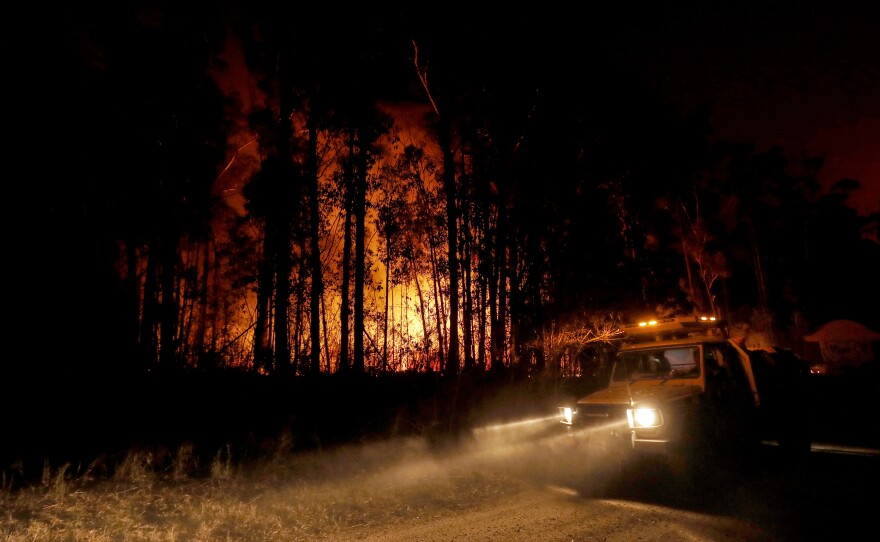As hard as it may be to believe, the bushfires ravaging large swaths of Australia are likely to get worse in the coming days.
Roughly two months after bushfires erupted in unprecedented numbers across the country's most populous state, authorities in New South Wales are declaring a state of emergency — the second in as many months. During a news conference Thursday, the state's premier, Gladys Berejiklian, warned that worsening conditions this coming weekend present further danger to residents and emergency responders struggling with the deadly blazes.
"We don't take these decisions lightly," Berejiklian told reporters, noting that high temperatures, unpredictable fire activity and heavy tourism could make for a dangerous combination.
"We want to make sure we're taking every single precaution to be prepared for what could be a horrible day on Saturday," Berejiklian said.
Citing a menacing cocktail of high temperatures and gusty winds, Australia's Bureau of Meteorology is predicting that "fire dangers on Saturday will reach severe to extreme yet again across fire sites and communities that have already seen large-scale devastation" — particularly in New South Wales and Victoria, though other states are likely to feel the effects too.
The forecast is unwelcome news for a country that has seen bushfires wreak death and destruction for weeks. In New South Wales alone, at least seven people have died — including at least three volunteer firefighters. And with more than 100 fires still ablaze there, local police are warning tourists to get out of the state's hard-hit southern regions. Thousands of evacuees clogged roads on their way out of the area Thursday, with some reportedly stuck in gridlock for up to 10 hours.
In neighboring Victoria, Premier Dan Andrews has declared a state of disaster for large portions of the state. The Victorian government notes that this is the first time it has used these powers — which differ in structure and nomenclature from those of New South Wales — since they were established more than a decade ago. Residents in several areas have been asked to leave their homes for their own safety.
Dozens of firefighters from the United States and Canada are set to join the more than 1,000 responders already battling the blazes in Victoria, which still numbered more than 50 as of Thursday.
Fires have also been reported in other states — including Queensland, Western Australia, South Australia and Tasmania. All told, the bushfires have killed at least 17 people, destroyed thousands of homes and burned more than 12 million acres of land — an area of land that, when combined, is twice the size of New Hampshire.
At a news conference of his own Thursday, Prime Minister Scott Morrison urged residents in Victoria and New South Wales to "remain patient and remain calm" amid the emergency response.
"I understand the anxiety, and I understand the fear that is there for many, and I understand the frustration," he said. "But this is a natural disaster and natural disasters are best dealt with through the methodical, well-coordinated response that we're seeing today."
The prime minister has come under criticism for his response to the fires. During a tour Thursday of the fire-ravaged town of Cobargo, New South Wales, angry residents heckled the Australian leader, telling him he was "not welcome" and calling him an "idiot."
Critics have pilloried Morrison for what they see as a lax response to the fires — including his decision to take a family vacation in Hawaii last month, before cutting the trip short and apologizing for "any offence" caused by the decision.
Others have criticized Morrison for his reluctance to link the bushfires with Australia's greenhouse gas emissions. While Morrison has acknowledged a link between climate change and bushfires, he says that Australia is already doing its part and that changing environmental policies would have done little to mitigate the effects of the fire season — a claim widely rejected by climate scientists.
The country, which has suffered years of drought, experienced its hottest day on record last month, reaching an average maximum temperature of 105.6 degrees Fahrenheit. And Australia has experienced nine of its 10 warmest years on record since 2005, according to the Australian government's Bureau of Meteorology.
The bureau's senior climatologist, Lynette Bettio, explained that last year in Australia, "every single state and territory had above-average day and night-time temperatures."
"Here's the contradiction in the government's position – they say, 'Oh, well, we're just 1.3% of [global] emissions, therefore we don't have a responsibility to act. It won't really make a difference' is what they're saying," Anthony Albanese, leader of the opposition Labor Party, told the Australian Broadcasting Corporation.
"But the truth is that if everyone says that, of course, no one will act — that's the first point. But the second point is we don't have credibility in those international forums."
Matters are likely to get worse still — not simply in the short term, but in the coming weeks and months, given the dry conditions and early start to Australia's typical bushfire season.
"It will continue to go on," Morrison said Thursday, "until we can get some decent rain that can deal with some of the fires that have been burning for many, many months."
Copyright 2020 NPR. To see more, visit https://www.npr.org.






